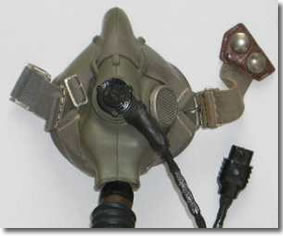RAF Communication Bits
Here are a few items of interest concerning RAF communication. Again, we are sticking mainly to the bits that we have not often seen elsewhere on the Internet. |
|
WREN Wireless Mechanic
 |
| A WREN Wireless Mechanic replaces an R/T set in a Sea Hurricane. R/T sets were not lightweight, but any mention of Health and Safety would have drawn a laugh in those days. |
Vintage Ground Controller's MicrophoneYes, it looks like an ordinary GPO candlestick telephone from the 1920s, but these were actually produced in a version for loudspeaker systems and wireless transmission. The sample you see here lacks the arm for the earpiece of the normal candlestick telephone and it also lacks the slot that that arm would have fitted in. The cable used by the microphone was shielded with an external copper braid. Look carefully at old newsreels of conferences in the 1930s and you may well see one in use. Also, if you happen to have seen the Canadian aviation film "The Arrow" you may have spotted one in use by the ground controller in the first few minutes of the film. |
 |
 |
Oxygen/Communications Mask Type E*The Type E oxygen/communications mask was the first to be adopted by the RAF after a number of years use of canvas ones. The Type E was made of a rather hard rubber moulding, and it seems that the narrow lining of chamois leather on the rim of the mask was often retained by aircrew for comfort, rather than trimmed off. Surviving Type E masks are often seen trimmed as they appear to have been issued in just one size. The oxygen pipe was provided with a rubber reinforcing hose just below the mask, and when oxygen was not in use air was drawn into the mask through the valve at the side. However, there was no exit valve, and so the air breathed out by aircrew simply leaked past the mask edge; which proably fogged the odd goggle at times. |
Oxygen/Communications Mask Type E* Interior ViewThe interior of the Type E mask was unlined. Here can be seen the interior of the air inlet valve and the business end of the Type microphone. When the Type E masks were scrapped the microphones were retained in stores and were often to be seen in the hands of air cadets taking air-experience flights in Chipmunks in the 1960s. |
 |
Oxygen/Communications Mask Type H |
|
 |
 |
The Type H oxygen/communications mask saw service towards the end of WWII. The Type H was moulded in much softer rubber than previous types and featured a pair of exit valves just under the microphone. It was first issued with a large microphone (left - simulated image), but was then modified to take a smaller one (right - real image), in which form it saw RAF service use for several decades - and there are many still in use today by pilots of vintage aircraft. |
|
Oxygen/Communications Mask Type H Interior ViewThe interior of the Type H mask was lined with chamois leather which reduced the problem of interior condensation. The inlet valve and the exit valves can be clearly seen in this shot. The mask came in three sizes; small, medium, and large. The oxygen hose was of the screw-on type rather than permanently fixed but the bayonet fitting on the end of the hose that connected to the oxygen supply was the same as for previous types of mask. The microphone plug that was inserted into the helmet loom socket was also the same as for previous masks. |
 |
 |
Trans Atlantic CableOkay, this is really stretching a theme, but during WWII the RAF, like many organisations, made use of trans-Atlantic cables. And just to stretch the theme even further; here is a piece of the first one that was laid successfully in 1866! The cable came in two sizes; thick, from the shore to deep, stable water, and thin, for the main undersea section. This is a sample of the main undersea section and is about one inch in diameter. The construction of the cable was; an outer casing of black gutta-percha (you can just see a remnant of this at the bottom of the cable cross-section), a steel armoured layer, a tough fibre layer, a bituminous layer, and finally the seven-wire copper conductor. This original cable ceased operating in the 1870s. |
© Copyright 2007 CairdPublications.com | Site Map | Contact Us |

